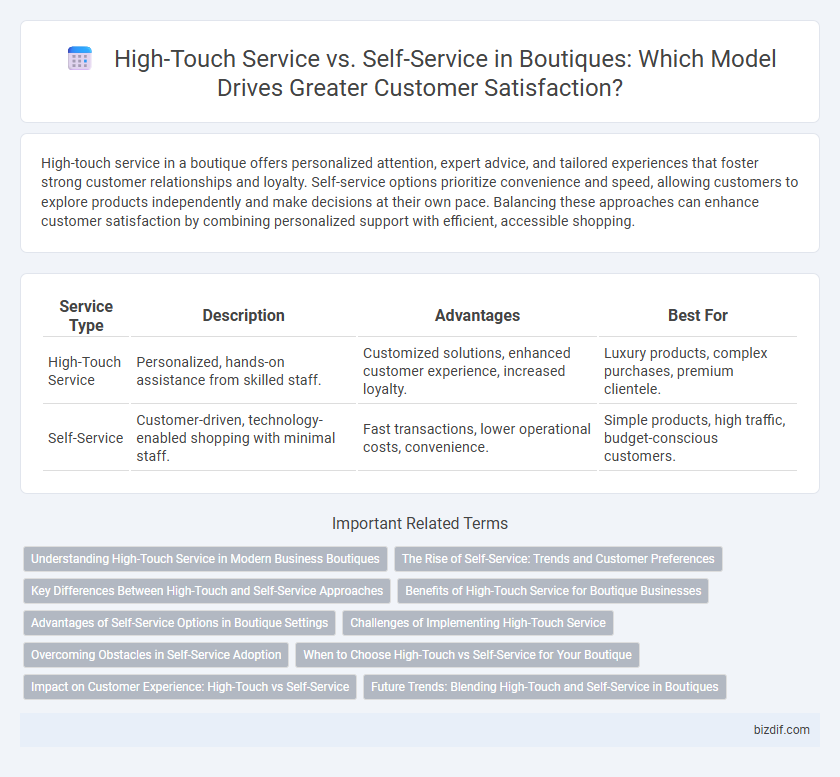High-touch service in a boutique offers personalized attention, expert advice, and tailored experiences that foster strong customer relationships and loyalty. Self-service options prioritize convenience and speed, allowing customers to explore products independently and make decisions at their own pace. Balancing these approaches can enhance customer satisfaction by combining personalized support with efficient, accessible shopping.
Table of Comparison
| Service Type | Description | Advantages | Best For |
|---|---|---|---|
| High-Touch Service | Personalized, hands-on assistance from skilled staff. | Customized solutions, enhanced customer experience, increased loyalty. | Luxury products, complex purchases, premium clientele. |
| Self-Service | Customer-driven, technology-enabled shopping with minimal staff. | Fast transactions, lower operational costs, convenience. | Simple products, high traffic, budget-conscious customers. |
Understanding High-Touch Service in Modern Business Boutiques
High-touch service in modern business boutiques emphasizes personalized customer interactions, fostering strong relationships through tailored experiences and attentive support. This approach leverages expert staff and customized solutions to enhance customer satisfaction and loyalty, differentiating boutiques from automated, self-service models. By prioritizing quality communication and individualized care, high-touch service drives higher-value engagement and long-term client retention in competitive markets.
The Rise of Self-Service: Trends and Customer Preferences
Boutiques increasingly embrace self-service options to meet growing customer demand for convenience and autonomy, reflecting shifts in retail trends. Interactive kiosks, mobile apps, and customizable online platforms enable shoppers to personalize experiences while reducing wait times. Data indicates that 65% of boutique customers prefer self-service tools for efficiency, highlighting its rising prominence over traditional high-touch service models.
Key Differences Between High-Touch and Self-Service Approaches
High-touch service emphasizes personalized customer interactions, offering tailored assistance through dedicated staff, which enhances customer satisfaction and loyalty in boutique settings. Self-service relies on technology platforms or automated systems, enabling customers to independently navigate products or services with convenience and speed. The key differences lie in the level of human engagement, customization, and the balance between efficiency and personal connection.
Benefits of High-Touch Service for Boutique Businesses
High-touch service in boutique businesses offers personalized interactions that deepen customer loyalty and enhance the overall shopping experience. Tailored recommendations and attentive assistance create a unique, memorable environment that distinguishes boutiques from larger retailers. This approach boosts customer satisfaction and encourages repeat visits, driving long-term revenue growth.
Advantages of Self-Service Options in Boutique Settings
Self-service options in boutique settings enhance customer convenience by offering 24/7 accessibility to product information and personalized recommendations through interactive kiosks or mobile apps. These solutions reduce wait times and empower shoppers to explore inventory at their own pace, improving overall satisfaction and operational efficiency. Integrating self-service technology also allows boutiques to collect valuable data on customer preferences, enabling tailored marketing strategies and inventory management.
Challenges of Implementing High-Touch Service
Implementing high-touch service in a boutique setting often faces challenges such as increased labor costs, the need for extensive employee training, and maintaining consistent personalized customer interactions. Balancing scalability with individualized attention becomes difficult, especially during peak shopping periods. Furthermore, integrating technology without compromising the bespoke experience requires strategic investment and careful execution.
Overcoming Obstacles in Self-Service Adoption
Overcoming obstacles in self-service adoption requires intuitive interface design and robust customer support to address users' frustrations and knowledge gaps. Seamless integration of AI-driven chatbots and personalized guidance helps bridge the gap between automated systems and human interaction in boutiques. Training customers on digital tools and emphasizing convenience can significantly increase adoption rates and enhance overall satisfaction.
When to Choose High-Touch vs Self-Service for Your Boutique
High-touch service enhances customer experience in boutiques by offering personalized attention, expert advice, and tailored product recommendations, ideal for luxury or custom items where buyer confidence is crucial. Self-service suits boutiques with high foot traffic or tech-savvy customers, streamlining the shopping process through digital kiosks or online platforms that enable convenience and speed. Choosing between high-touch and self-service depends on factors like product complexity, customer preference, and the boutique's operational capacity to balance personalized care with efficiency.
Impact on Customer Experience: High-Touch vs Self-Service
High-touch service in boutiques creates personalized customer experiences through attentive, face-to-face interactions that foster loyalty and satisfaction. Self-service options empower customers with convenience and speed, appealing to those who prefer autonomy and efficiency. The impact on customer experience depends on balancing personalized attention with streamlined service to meet diverse consumer preferences.
Future Trends: Blending High-Touch and Self-Service in Boutiques
Future trends in boutiques emphasize the seamless integration of high-touch service and self-service technologies to enhance customer experience. Personalized consultations powered by AI-driven insights complement automated checkouts and virtual try-ons, creating a hybrid model that caters to both convenience and bespoke attention. This blend leverages data analytics and human expertise to deliver tailored shopping journeys that anticipate customer needs while maintaining efficiency.
High-Touch Service vs Self-Service Infographic

 bizdif.com
bizdif.com